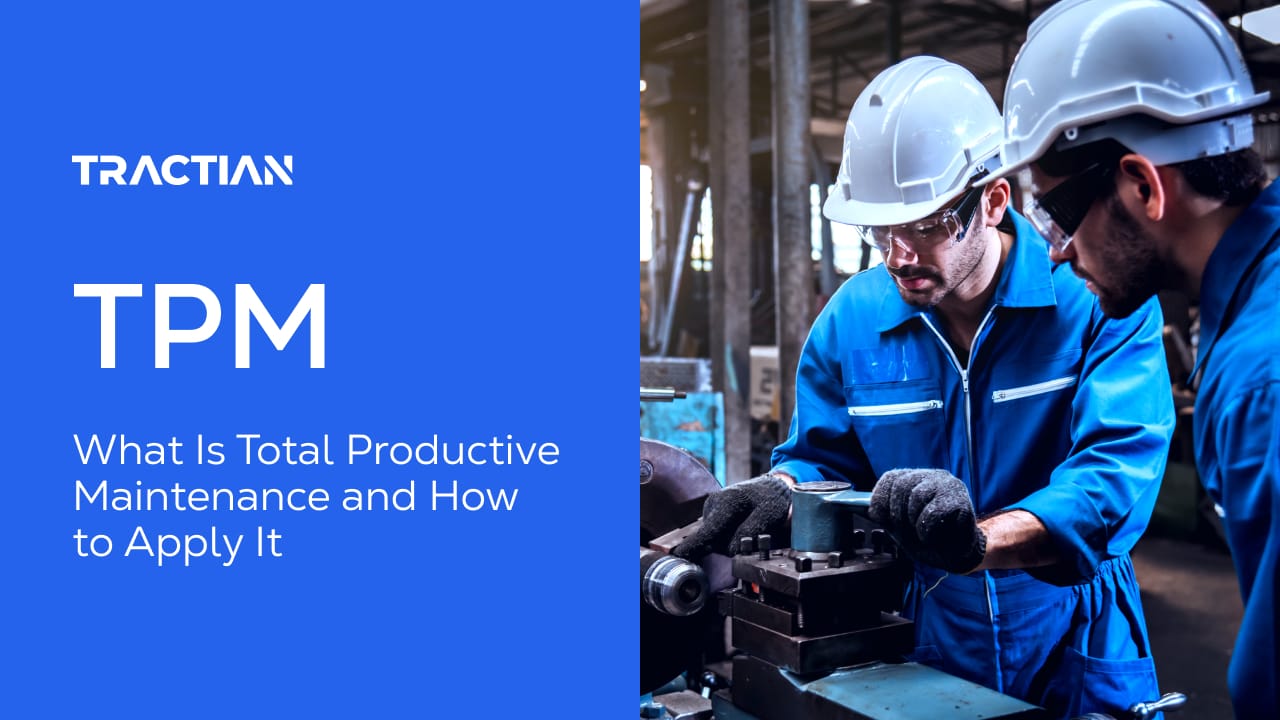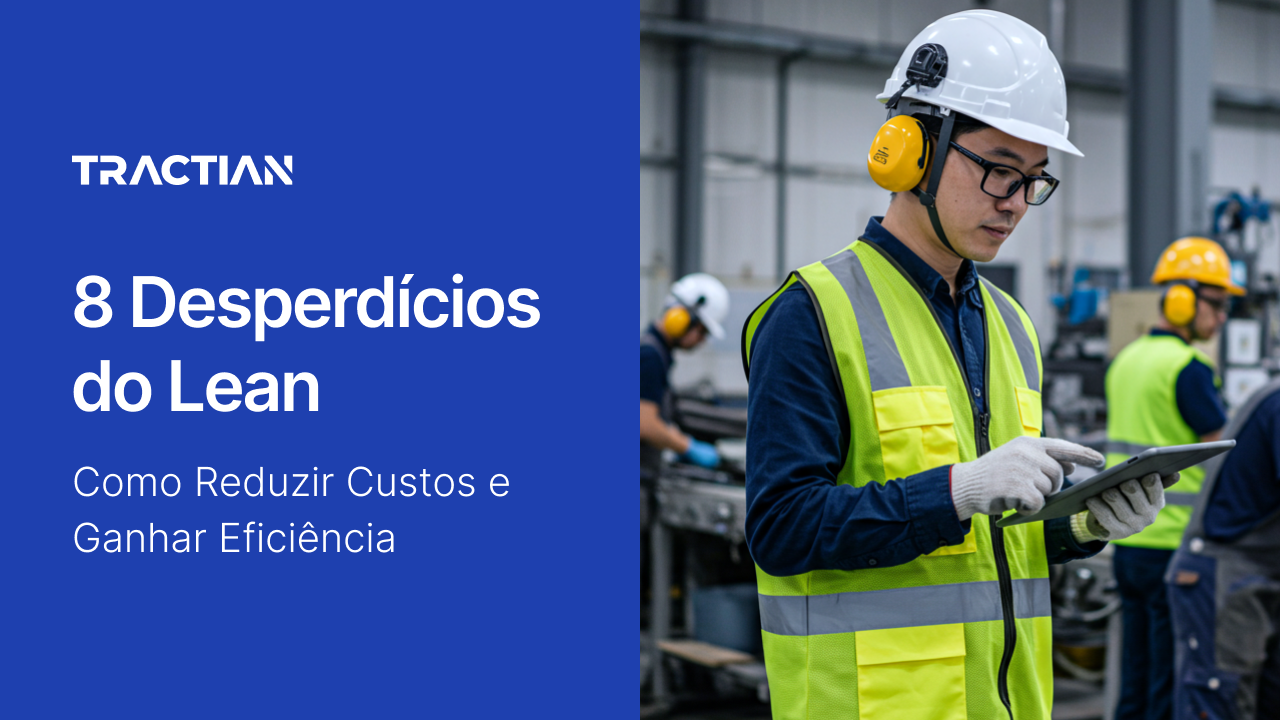Total Productive Maintenance (TPM) is one of the most effective strategies available if you're looking to boost operational efficiency and improve productivity in industrial settings.
TPM, far from a traditional maintenance approach, is a comprehensive philosophy of continuous improvement that transforms how organizations manage equipment and optimize manufacturing processes.
At its core, TPM aims to ensure every piece of equipment operates at peak performance while eliminating waste, defects, and downtime.
In this guide, we’ll explore what TPM is, why it’s a game-changer for manufacturing, and how to implement it for maximum impact.
What Is Total Productive Maintenance (TPM)?
Total Productive Maintenance (TPM) is a comprehensive maintenance management system designed to maximize industrial equipment efficiency. TPM engages everyone in the organization, from machine operators to senior leadership.
Originally developed in Japan, TPM focuses on building a culture of shared responsibility, where operators and maintenance personnel work together to maintain and improve equipment.
Unlike traditional maintenance, where technicians bear sole responsibility, TPM encourages employees at every level to take ownership of their equipment, proactively identifying and eliminating potential issues.
Guiding Principles of TPM:
- Zero Equipment Failures: Strive for consistent reliability through planned maintenance and proactive strategies.
- Zero Defects: Minimize production defects by integrating quality maintenance directly into manufacturing processes.
- Zero Accidents: Foster a safer, healthier work environment by eliminating hazards and ensuring workforce well-being.
These principles are reinforced by proactive and preventive maintenance, routine maintenance, and focused improvement activities, all of which contribute to higher overall equipment effectiveness (OEE).
What Is TPM Used For?
TPM’s benefits go beyond equipment efficiency. It directly supports key business objectives related to operating costs, quality management, and production performance.
1. Enhancing Operational Efficiency
TPM rminimizes unplanned downtime by keeping machines in prime operating condition through autonomous maintenance and early equipment management. As a result, production flows more predictably, reducing delays and defects.
When maintenance teams and equipment operators collaborate using standard procedures and data-driven insights, they can detect and prevent failures before they escalate, improving both equipment efficiency and productivity.
2. Reducing Costs and Waste
TPM helps cut down on costly corrective maintenance and emergency repairs. By focusing on failure rates and major losses—such as breakdowns or defective production—TPM strategies significantly reduce expenses related to repairs and material waste.
How Does TPM Work?
- Increased Equipment Uptime: Machines are ready when needed, supporting smoother production processes and higher output.
- Cost Optimization: Reducing defect production and unnecessary maintenance tasks allows operating budgets to be allocated more strategically.
- Safer Workplaces: TPM ensures a safer workplace by addressing hazards through regular maintenance schedules and proactive risk mitigation.
The 8 Pillars of Total Productive Maintenance (TPM)
Within the Total Productive Maintenance (TPM) framework, success is built on eight interconnected pillars, each playing a crucial role in boosting productivity, optimizing equipment efficiency, and ensuring a safer workplace.
Let’s break them down:

1. Autonomous Maintenance
This pillar empowers machine operators to take ownership of routine maintenance, including inspections, cleaning, lubrication, and minor repairs.
By training operators to identify and resolve minor issues, companies can prevent major failures before they happen, minimizing downtime, extending machine lifespan, and strengthening operators' practical knowledge of equipment behavior.
2. Safety, Health, and Environment
Unlike many strategies, safety isn’t a secondary objective or an afterthought tacked on for best practices. Instead, it’s a core part of TPM. This pillar ensures a healthy work environment by embedding safety protocols and environmental safeguards into daily maintenance activities.
When accident prevention is prioritized alongside productivity, workplace morale improves, and manufacturing processes become safer and more efficient.
3. Initial Control
This foundational pillar focuses on diagnosing and addressing chronic issues early in the TPM process. Root cause analysis is applied to identify and eliminate recurring failures, establish stable processes, and streamline production processes.
4. Quality Maintenance
Quality maintenance is focused on detecting and eliminating recurring quality defects by continuously monitoring equipment performance and customer feedback.
By integrating continuous improvement strategies and technological upgrades, organizations can keep equipment in prime operating condition and enhance overall equipment effectiveness (OEE).
5. Administrative Functions
Administrative support is vital to effectively implementing TPM. Leaders must ensure that maintenance programs are streamlined, schedules are followed, and resources—like spare parts inventory—are properly managed.
A smooth flow of information across departments enables faster decision-making and ensures maintenance staff can act on real-time data.
6. Focused Improvement
Also known as specific improvements, this pillar drives continuous optimization at both the equipment and process levels.
Multidisciplinary teams—including production, maintenance, and quality control—collaborate to reduce significant losses, minimize downtime, and enhance operational performance.
7. Planned Maintenance
This pillar shifts maintenance from a reactive approach to a proactive strategy by implementing a structured, data-driven system of planned maintenance.
Regular inspections, scheduled repairs, and proactive maintenance activities ensure equipment operates at planned performance levels and remains reliable over time.
8. Preventive Maintenance (PM) Scheduling
To eliminate waste and maximize uptime, companies must implement preventive maintenance schedules based on the criticality of each asset.
By leveraging failure rates and performance data, maintenance tasks are scheduled before issues arise, ensuring equipment runs at peak efficiency and avoids costly breakdowns.
The 5 Goals of TPM
At its core, Total Productive Maintenance (TPM) revolves around five key goals, all focused on helping manufactures eliminate waste, minimize downtime, and drive operational excellence.
When fully implemented, these goals create a culture of shared responsibility and drive continuous improvement across manufacturing operations.
Let’s explore the five essential pillars of TPM success:

1. Zero Equipment Failures
Equipment breakdowns are a major contributors lost production and increased operating costs.
TPM aims to achieve zero equipment failures by implementing proactive and preventive maintenance programs, equipping maintenance teams and machine operators with the tools to perform routine maintenance and early equipment management.
How to Achieve It:
- Implement planned maintenance schedules and condition monitoring.
- Use root cause analysis to identify and eliminate recurring failures.
- Train operators to recognize early signs of wear or malfunction.
2. Zero Defects
Quality defects can result in wasted production, costly recalls, and damaged customer trust. TPM addresses this through quality maintenance initiatives, ensuring defects are identified and eliminated at the source.
How to Achieve It:
- Perform continuous inspections and integrate quality management checks throughout the production process.
- Collaborate with operators and engineers to detect and correct defects early.
- Utilize improvement activities to minimize rework and scrap.
3. Zero Waste & Increased Efficiency
One of TPM’s primary goals is to eliminate waste across manufacturing processes—time, resources, and excess materials. This two-pronged goal of reducing unnecessary costs and boosting output is aligned with lean manufacturing principles.
How to Achieve It:
- Conduct regular maintenance activities to reduce unplanned downtime.
- Optimize equipment maintenance to minimize energy and resource consumption.
- Standardize procedures to improve workflow and eliminate inefficiencies.
4. Zero Workplace Accidents
A safe and healthy work environment is fundamental to employee well-being, productivity, and retention. By addressing safety hazards through routine maintenance and risk assessments, TPM aims to create workplaces free from accidents.
How to Achieve It:
- Enforce routine equipment inspections to ensure safe operating conditions.
- Implement safety protocols into all maintenance programs.
- Train employees on safe operating practices and hazard identification.
5. Employee Involvement & Ownership
TPM thrives on empowering operators to take ownership of equipment maintenance and process improvements. Engaged employees increase accountability, strengthen teamwork, and sustain long-term success.
How to Achieve It:
- Encourage operator participation through autonomous maintenance programs.
- Invest in training and education for both maintenance staff and equipment operators.
- Recognize and reward contributions to continuous improvement initiatives.
Benefits of Total Productive Maintenance (TPM)
A well-executed Total Productive Maintenance (TPM) program drives measurable improvements in production processes, maintenance performance, and workplace culture.
By reducing failure rates, optimizing equipment usage, and fostering a safer, more collaborative environment, TPM helps manufacturers achieve long-term operational gains while keeping operating costs under control.
Here are the key benefits that demonstrate the value of TPM programs:

1. Fewer Breakdowns
A central objective of TPM is to prevent equipment failures before they happen through proactive and preventive maintenance.
TPM ensures machines operate smoothly with minimal disruptions by engaging operators and maintenance teams in routine and planned maintenance activities.
- Impact: Reduced unplanned downtime and fewer costly repairs.
- How to Achieve It: Implement failure analysis and early equipment management to identify and address issues before they lead to breakdowns.
2. Safer Workplace
TPM prioritizes workplace safety by embedding safety measures into daily maintenance routines.
By proactively identifying hazards and integrating safety health environment protocols into maintenance schedules and inspections, TPM helps reduce workplace accidents and improve employee well-being.
- Impact: Fewer injuries, greater employee retention, and improved productivity.
- How to Achieve It: Integrate safety checks into autonomous maintenance and conduct regular equipment inspections to ensure safe operation.
3. Increased Productivity Rates
Machines running at planned performance levels and experiencing fewer disruptions improve overall equipment effectiveness (OEE).
TPM optimizes production output by ensuring equipment operates efficiently, eliminating bottlenecks caused by breakdowns or defects.
- Impact: Higher production rates and fewer workflow interruptions.
- How to Achieve It: Implement focused improvement activities and encourage teams to participate in continuous improvement initiatives targeting significant losses.
4. Reduced Waste and Product Defects
TPM supports lean manufacturing by eliminating waste and reducing defect production.
By integrating quality maintenance practices and conducting regular inspections, TPM ensures that products meet quality standards from the outset, minimizing rework and scrap.
- Impact: Lower material waste, reduced rework, and improved product quality.
- How to Achieve It: Monitor quality defects continuously and optimize maintenance tasks to address recurring issues.
5. Lower Operating Costs
TPM significantly reduces emergency repairs, unplanned expenses, and excessive labor costs by establishing routine and planned maintenance schedules.
With a strong focus on predictive and preventive maintenance, TPM helps extend equipment lifespan and prevent costly failures.
- Impact: Lower maintenance costs and optimized resource allocation.
- How to Achieve It: Conduct periodic inspections and early interventions to prevent expensive breakdowns.
6. Empower Your Workers
TPM shifts maintenance responsibility from a centralized team to a collaborative model, where machine operators take an active role in equipment upkeep.
This hands-on involvement increases employee engagement, enhances operational knowledge, and fosters a greater sense of ownership.
- Impact: Employees gain practical knowledge, leading to better equipment maintenance and overall efficiency.
- How to Achieve It: Train and involve operators through autonomous maintenance and structured training programs.
7. Take a Proactive Approach to Quality
TPM embeds quality maintenance directly into the production process, ensuring defects are identified early and corrected before escalating.
Manufacturers can reduce rework, improve customer satisfaction, and enhance product quality by taking a proactive stance.
- Impact: Consistently high-quality products with fewer returns or defects.
- How to Achieve It: Conduct ongoing inspections, monitor quality defects, and apply root cause analysis to eliminate recurring issues.
The 5S Foundation
The 5S methodology is a fundamental pillar of Total Productive Maintenance (TPM), providing the structure needed to organize the workplace, improve efficiency, and support long-term continuous improvement.
Implementing 5S principles ensures maintenance activities are systematic, equipment is operating at peak performance, and teams are better equipped to detect and prevent breakdowns early. Here’s how the 5S foundation integrates into TPM’s core actions:
1. Identify a Pilot Area
Launching TPM starts with selecting a pilot area—a machine, production line, or plant section where initial implementation occurs.
The chosen area should include assets critical to production with measurable performance outcomes. This allows teams to test TPM processes, achieve early wins, and refine strategies before scaling across the facility.
2. Restore Equipment to Prime Operating Condition
Once the pilot area is identified, the next step is restoring equipment to prime operating condition.
This involves inspections, repairs, and deep cleaning to eliminate minor issues that could lead to equipment failures. Operators and maintenance teams work together to address wear and tear while developing preventive measures to sustain performance.
3. Start Measuring OEE (Overall Equipment Effectiveness)
OEE is one of the most valuable maintenance metrics, offering insight into equipment efficiency and production performance.
Once equipment is restored, OEE tracking begins, measuring availability, performance, and quality (APQ). Any performance gaps highlight areas that need improvement.
4. Address Major Losses
TPM focuses on identifying and eliminating the six major losses affecting production, including equipment breakdowns, minor stops, reduced speed, defects, and setup or adjustment delays.
OEE data reveals performance gaps, allowing teams to apply root cause analysis and take targeted actions to reduce or eliminate these losses.
5. Introduce Proactive Maintenance Techniques
A proactive and preventive maintenance approach is essential for sustaining TPM improvements over time.
This involves transitioning from reactive repairs to scheduled inspections, planned overhauls, and condition-based interventions. Operators and technicians monitor equipment continuously, using data to refine maintenance schedules and improve asset reliability.
How to Implement Total Productive Maintenance (TPM)
Successfully implementing Total Productive Maintenance (TPM) requires a structured, step-by-step approach that balances planning, monitoring, and continuous improvement.
The objective is to foster a collaborative maintenance environment where teams work proactively to reduce downtime, optimize productivity, and ensure equipment runs at peak efficiency.
1. Identify a Pilot Area
Begin by selecting a pilot area within the facility to test and refine TPM practices before rolling them out across the organization.
This could be a production line, critical equipment, or a section of the plant where maintenance improvements would have a measurable impact on overall equipment effectiveness (OEE) and operational performance.
Prioritize assets with trackable performance indicators and areas prone to frequent breakdowns or defects.
2. Restore Equipment to Prime Operating Condition
Once the pilot area is established, the next step is to restore equipment to prime operating condition.
This involves comprehensive inspections, repairing or replacing worn components, and deep cleaning machinery to eliminate hidden issues that could cause failures.
Both maintenance teams and machine operators play a role in this phase, with operators performing autonomous maintenance tasks such as cleaning, lubrication, and minor repairs.
3. Measure OEE (Overall Equipment Effectiveness)
Tracking OEE is essential to evaluate the impact of TPM implementation and identify areas for further improvement.
OEE metrics assess three critical factors: equipment availability, performance efficiency, and quality output.
By monitoring these key indicators, teams can pinpoint major losses that hinder production efficiency, such as unplanned downtime, speed reductions, and recurring quality defects.
4. Address and Reduce Major Losses
Reducing major losses is crucial for sustaining long-term equipment efficiency and improving maintenance management.
Once OEE data identifies underperforming areas, teams should conduct root cause analysis and implement corrective actions.
Common inefficiencies—such as extended setup times, frequent stoppages, and minor but recurring breakdowns—should be addressed through collaborative problem-solving between maintenance staff, operators, and production teams.
Reducing failure rates improves production output, extends asset lifespan, and enhances overall equipment reliability.
5. Implement Planned Maintenance
With major inefficiencies resolved, the next step is to develop a structured, planned maintenance program tailored to the specific needs of each asset.
Transition from reactive maintenance to a proactive, data-driven approach, incorporating regular inspections, condition-based interventions, and scheduled overhauls.
Prioritize maintenance activities based on asset criticality and impact on production to ensure long-term equipment reliability and operational stability.
Take Your Maintenance Strategy to the Next Level with TPM
Keeping machines running is a byproduct of Total Productive Maintenance (TPM). TPM's actual value is in its strategic approach to achieving peak production, minimizing inefficiencies, and fostering a safer, more collaborative work environment.
With planned maintenance schedules, proactive maintenance techniques, and focused improvement activities, TPM addresses the root causes of equipment inefficiencies while empowering operators to take ownership of maintenance and continuous improvement.
When fully implemented, TPM optimizes overall equipment effectiveness (OEE), lowers operating costs, and embeds a culture of continuous improvement across departments.
But success with TPM doesn’t happen overnight.
It requires a structured approach, starting with small-scale implementation in a pilot area, restoring equipment to peak condition, and continuously tracking performance with OEE data to drive ongoing improvements.
Whether you’re just getting started with TPM or looking to scale it across your entire operation, the key to long-term success lies in collaboration, continuous monitoring, and adapting to evolving production demands.
This is where Tractian can help.
Our solutions—built to streamline maintenance management and enhance equipment efficiency—provide real-time condition monitoring, AI-powered insights, and predictive maintenance tools to help you detect and prevent failures before they occur.
With integrated OEE tracking, automated maintenance schedules, and actionable alerts, your team can eliminate maintenance guesswork and drive sustainable performance improvements at every level of production.




